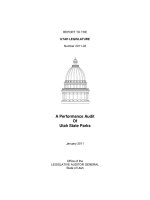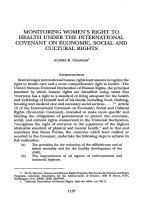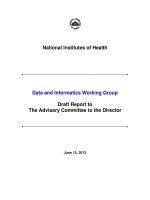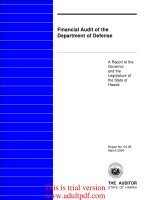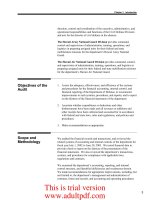UGANDA’S INITIAL STATE REPORT TO THE UN COMMITTEE ON ECONOMIC SOCIAL AND CULTURAL RIGHTS
Bạn đang xem bản rút gọn của tài liệu. Xem và tải ngay bản đầy đủ của tài liệu tại đây (707.2 KB, 82 trang )
ADVANCED UNEDITED VERSION
UGANDA’S INITIAL STATE REPORT TO
THE UN COMMITTEE ON ECONOMIC
SOCIAL AND CULTURAL RIGHTS
JULY 2012
LIST OF ACRONYMS..........................................................................................................................................v
Introduction...................................................................................................................................................... 1
I. CORE DOCUMENT......................................................................................................................................1
A. LAND AND PEOPLE (INCLUDING ECONOMIC, SOCIAL AND CULTURAL CHARACTERISTICS) .................1
GENERAL POLITICAL STRUCTURE;................................................................................................................ 2
GENERAL LEGAL FRAMEWORK.................................................................................................................... 3
INFORMATION AND PUBLICITY.................................................................................................................... 4
LEGAL STATUS AND SPECIFIC IMPLEMENTATION OF THE COVENANT....................................................... 4
Legal status of the ICESCR............................................................................................................................ 4
Role of International Cooperation............................................................................................................... 5
REPORTING ON THE SUBSTANTIVE PROVISIONS............................................................................................ 5
ARTICLE 1 - THE RIGHT TO SELF DETERMINATION ......................................................................................... 5
Recognition and Protecting indigenous communities, Ownership of the lands and territories: .........6
Challenges: ............................................................................................................................................... 7
ARTICLE 2 - PROGRESSIVE REALISATION OF RIGHTS ...................................................................................... 7
ARTICLE 3 - NON DISCRIMINATION and EQUALITY ......................................................................................... 7
Challenges: ............................................................................................................................................... 9
ARTICLE 6: RIGHT TO WORK .......................................................................................................................... 10
Measures taken to reduce unemployment .......................................................................................... 10
Targeted employment programmes: .................................................................................................... 12
Measures to facilitate re-employment of workers ............................................................................... 13
Information on work in the informal sector: ........................................................................................ 14
Access to basic services and Social protection under informal economy: ..........................................14
Legal safeguards in place to protect workers from unfair dismissal ...................................................15
Technical and vocational training programmes ................................................................................... 15
Uganda’s Initial State Report to the UN Committee on ESCRs, July 2012
i
Challenges .............................................................................................................................................. 16
ARTICLE 7
RIGHT TO JUST AND FAVOURABLE CONDITIONS OF WORK ...................................................17
Right to fair conditions of employment: .............................................................................................. 17
ARTICLE 8 - RIGHT TO FORM AND JOIN TRADE UNIONS .............................................................................. 18
ARTICLE 9 - RIGHT TO SOCIAL SECURITY ....................................................................................................... 19
ARTICLE 10 - PROTECTION OF THE FAMILY .................................................................................................. 21
Equal Opportunities Commission Act 2007 .......................................................................................... 22
Asylum seekers ...................................................................................................................................... 23
Domestic violence ................................................................................................................................. 23
ARTICLE 11 - THE RIGHT TO ADEQUATE STANDARD OF LIVING ................................................................... 23
Targeted policies .................................................................................................................................... 25
RIGHT TO FOOD. ............................................................................................................................................ 26
Food Availability: ................................................................................................................................... 27
RIGHT TO WATER ........................................................................................................................................... 27
Water coverage ...................................................................................................................................... 28
Water affordability ................................................................................................................................. 28
RIGHT TO ADEQUATE HOUSING: .................................................................................................................. 29
Access to adequate and affordable housing with legal security of tenure .........................................30
Measures taken to make housing accessible and habitable for persons with special housing needs:
............................................................................................................................................................ 31
ARTICLE 12 - THE RIGHT TO HEALTH ............................................................................................................. 33
Health Policy framework ....................................................................................................................... 33
Uganda National Health System (NHS) ................................................................................................. 33
Health Promotion and Education ......................................................................................................... 34
Sexual Reproductive Health and Rights (SRH) ...................................................................................... 35
Management of Common Childhood Illness: ....................................................................................... 35
Expanded Programme for Immunization (EPI) ..................................................................................... 35
Nutrition: ............................................................................................................................................... 36
Prevention and control of STI/HIV/AIDS ............................................................................................... 36
Malaria: .................................................................................................................................................. 36
Disease targeted for elimination and/or eradication: .......................................................................... 37
Leprosy: .................................................................................................................................................. 37
Guinea worm ......................................................................................................................................... 37
Trachoma: .............................................................................................................................................. 37
Mechanisms for scaling up interventions for the Control of Communicable Diseases: .....................38
Prevention and Control of Non-Communicable Diseases: ...................................................................38
Injuries, disabilities and Rehabilitative Health: .................................................................................... 38
Oral Health: ........................................................................................................................................... 39
Pentavalent Vaccine Coverage: ............................................................................................................. 40
HIV/AIDS Control: .................................................................................................................................. 40
Health promotion, disease prevention and community health initiatives: ........................................40
Environmental health ............................................................................................................................ 40
Household latrine coverage .................................................................................................................. 40
Maternal and child health ..................................................................................................................... 41
Integrated child survival ........................................................................................................................ 41
Management of Common Childhood Illnesses: ................................................................................... 41
Expanded Programme for Immunization: ............................................................................................. 41
Tuberculosis: .......................................................................................................................................... 42
HEALTH CARE FINANCING ......................................................................................................................... 42
NATIONAL HEALTH INSURANCE POLICY (NHIS) .................................................................................... 42
ARTICLE - 13 & 14 RIGHT TO EDUCATION .................................................................................................... 42
Primary Education Sub-sector ............................................................................................................... 42
Limitations in the realization of the Free Compulsory Primary Education .........................................43
204. Cross-cutting challenges in the sub-sector .......................................................................................43
Secondary School Sub-sector enrolment 1986 – 2010 ............................................................................ 44
Regional Distribution of Secondary School enrolment ........................................................................ 45
Existing Strategies and Plans to realize the Covenant right: ................................................................ 45
Constraints and Challenges ................................................................................................................... 46
University Education ............................................................................................................................. 47
Counter measures to the Challenges of Higher Education Sub-sector: ..............................................48
ARTICLE 15 - RIGHT TO TAKE PART IN CULTURAL LIFE ............................................................................... 48
Existing Policy Issues ............................................................................................................................. 48
Existing programmes, strategies, and plans: ........................................................................................ 49
Institutional infrastructure to promote popular participation in, and access to, cultural life,
especially at the community level, including in rural and deprived urban areas ...............................49
Measures taken to protect cultural diversity, promote awareness of the cultural heritage ..............50
Information on school and professional education in the field of culture and the arts: ........................50
Measures to ensure affordable access to the benefits of scientific progress and its applications for
everyone, including disadvantaged and marginalized individuals and groups .......................................50
Measures to protect the right of authors to be recognized as the creators and for the protection of
the integrity of their scientific, literary and artistic productions ............................................................. 51
Measures to ensure the protection of the moral and material interests of indigenous peoples relating
to their cultural heritage and traditional knowledge ............................................................................... 51
Challenges .............................................................................................................................................. 51
Uganda’s
Uganda’s Initial
Initial State
State Report
Report to
to the
the UN
UN Committee
Committee on
on ESCRs,
ESCRs, July
July 2012
2012
3ii
LIST OF ACRONYMS AND ABBREVIATIONS:
ACT
Artemisinin Combination Therapies
ADB
African Development Bank
AFP
Acute Flaccid Paralysis
AHSPR
Annual Health Sector Performance Report
AIDS
Acquired Immuno-Deficiency Syndrome
ANC
Ante Natal Care
APH
Ante Partum Haemorrhage
ART
Anti-retroviral Therapy
ARVs
Antiretroviral Drugs
AT
Area Team
AZT
Azidothymidine
BCC
Behavioral Change and Communication
BCG
Bacille Calmette Guerin
BTVET
Business Technical Vocational Education and Training
BFHI
Baby Friendly Health Initiative
BOP
Best Operational Practices
CAO
Chief Administrative Officer
CB-DOTS
Community Based TB Directly Observed Treatment
CBOs
Community Based Organizations
CDC
Centre for Disease Control
CDD
Control of Diarrheal Diseases
CDP
Child Days Plus
CMD
Community Medicine Distributor
Uganda’s
Uganda’s Initial
Initial State
State Report
Report to
to the
the UN
UN Committee
Committee on
on ESCRs,
ESCRs, July
July 2012
2012
4ii
CPHL
Central Public Health laboratories
Uganda’s
Uganda’s Initial
Initial State
State Report
Report to
to the
the UN
UN Committee
Committee on
on ESCRs,
ESCRs, July
July 2012
2012
5ii
CSO
Civil Society Organization
CYP
Couple Years of Protection
DANIDA
Danish International Development Assistance
DCCAs
District Cold Chain Assistants
DDT
Dichlorodiphenyltrichloroethane
DHO
District Health Officer
DHT
District Health Team
DLT
District League Table
DOTS
Directly Observed Treatment, short course (for TB)
DPs
Development Partners
DPT
Diphtheria, Pertussis (whooping cough) and Tetanus vaccine
DTLS
District TB/Leprosy Supervisor
EID
Early Infant Diagnosis EMHS Essential Medicines and Health Supplies
EmOC
Emergency Obstetric Care
ENT
Ear, Nose and Throat
ESIP
Education Strategic Investment Plan
EQA
External Quality Assessment
FAL
Functional Adult Literacy Programme
FMS
First Monitoring Survey
FP
Family Planning
FUE
Federation of Uganda Employers
FY
Financial Year
GAVI
Global Alliance for vaccines and Immunization
GDP
Gross Domestic Product
GLRA
German Leprosy Relief Association
Uganda’s Initial State Report to the UN Committee on ESCRs, July 2012
vi
GOU
Government of Uganda
HAART
Highly Active Anti-Retroviral Therapy
HANDSEDS
Handicraft Sector Export Development Strategy
HBMF
Home Based Management of Fever
HC
Health Centre
HCI
Health Care Improvement
HCT
(HIV/AIDS) Counselling and Testing
HDP
Health Development Partners
HIB
Haemophilus Influenzae type B
HIV
Human Immuno-Deficiency Virus
HMIS
Health Management Information System
HPA
Hospital /HC IV Performance Assessment
HPAC
Health Policy Advisory Committee
HRH
Human Resource for Health
HSD
Health Service District
HSD
Health Sub-Districts
HSSIP
Health Sector Strategic Investment Plan
HSSP
Health Sector Strategic Plan
HUMC
Health Unit Management Committees
ICN
International Council of Nursing
ICT
Information Communication Technology
ICU
Intensive Care Unit
IDSR
Integrated Disease Surveillance and Response
IEC
Information Education and Communication
IGG
Inspector General of Government.
Uganda’s Initial State Report to the UN Committee on ESCRs, July 2012
vii
IMAM
Integrated Management of Acute Malnutrition
IMCI
Integrated Management of Childhood Illness
IST
In-service training
ITNs
Insecticide Treated Nets
IVM
Integrated Vector Management
IYCF
Infant and Young Child Feeding
JAF
Joint Assessment Framework
JBSF
Joint Budget Support Framework
JICA
Japan International Cooperation Agency
JMS
Joint Medical Stores
JRM
Joint Review Missions
LF
Lymphatic Filariasis
LLINs
Long Lasting Insecticide Treated Nets
LTIA
Long Term Institutional Arrangements
MAAIF
Ministry of Agriculture, Animal Industries and Fisheries
MDG
Millennium Development Goals
MGLSD
Ministry of Gender Labour and Social Development
MoES
Ministry of Education and Sports
MTCBS
The Medium Term Competitive Business Strategy
M&E
Monitoring and Evaluation
MCH
Maternal and Child Health
MDGs
Millennium Development Goals
MDR
Multi-drug Resistant
MH
Mental Health
MMA
Mass Medicine Administration
Uganda’s Initial State Report to the UN Committee on ESCRs, July 2012
viii
MMR
Maternal Mortality Rate
MOFPED
Ministry of Finance, Planning and Economic
Development MoGLSD
Ministry of Gender, Labour and Social
Development MOH Ministry of Health
MOLG
Ministry of Local Government
MOPS
Ministry of Planning and Survey
MOPS
Ministry of Public Service
MOU
Memorandum of Understanding
MTEF
Medium Term Expenditure Framework
NAADS
National Agricultural Advisory Services
NCD
Non Communicable Diseases
NCRL
National Chemotherapeutic Research Laboratories
NCRL
National Chemotherapeutics Research Laboratory
NDA
National Drug Authority
NAADS
National Agricultural Advisory Services
NAES
National Agricultural Education and Training Strategy
NARS
National Agricultural Research System
NDP
National Development Plan
NGOs
Non Governmental Organizations
NHA
National Health Assembly
NHP
National Health Policy
NMCP
National Malaria Control Strategic Plan
NMS
National Medical Stores
NTDs
Neglected Tropical Diseases
NTLP
National Tuberculosis and Leprosy Control Program
Uganda’s Initial State Report to the UN Committee on ESCRs, July 2012
ix
NOTU
National Organization of Trade Unions
NRA
National Resistance Army
NRM
National Resistance Movement
OBB
Output Based Budget
OH &S
Occupational Health and Safety
OPD
Outpatients Department
OPM
Office of the Prime Minister
OPV
Oral Polio Vaccine
ORS
Oral Rehydration Salt
ORT
Oral Rehydration Therapy
PAF
Poverty Action Fund
PAM
Plan for Modernization of Agriculture
PEAP
Poverty Eradication Action Plan
PHA
People with HIV/AIDS
PHAST
Participatory Hygiene and Sanitation Transformation
PHC
Primary Health Care
PLWHA
People with HIV/AIDS
PMA
Plan for Modernization of Agriculture
PMI
President's Malaria Initiative
PMTCT
Prevention of Mother to Child Transmission
PNFP
Private Not for Profit
PRDP
Peace Recovery and Development Plan
PSR
Poverty Status Report
PWD
Persons with Disabilities
QAD
Quality Assurance Department
Uganda’s Initial State Report to the UN Committee on ESCRs, July 2012
x
RDT
Rapid Diagnostic Test
RH
Reproductive Health
RPF
Re-use Prevention Features
RRH
Regional Referral Hospital
RUTF
Ready to Use Foods
ROM
Result Oriented Management
SEP
Strategic Exports Programme
SER
Socio- Economic Rehabilitation
SHSSPP
Support to the Health Sector Strategic Plan Project
SIDA
Swedish International Development Agency
SME
Small and Medium scale Enterprise
SMER
Supervision, Monitoring, Evaluation and Research
SDIP
Social Sector Development Investment Plan
SP
Sulfadoxine/Pyrimethamine
STI
Sexually Transmitted Infection
SUO
Standard unit of Output
SWAP
Sector-Wide Approach
TB
Tuberculosis
TMC
Top Management Committee
TT
Tetanus Toxoid
TVET
Technical, Vocational Education and Training
TWG
Technical Working Group
UBOS
Uganda Bureau of Statistics
UBTS
Uganda Blood Transfusion Services
UEPB
Uganda Export Promotion Board
Uganda’s Initial State Report to the UN Committee on ESCRs, July 2012
xi
UCMB
Uganda Catholic Medical Bureaux
UDHS
Uganda Demographic and Health Survey
UGFATM
Uganda Global Fund for AIDS, TB and Malaria
UNHS
Uganda National Household Survey
UNDP
United Nation Development Programme
UNEPI
Uganda Expanded Programme on Immunization
UNFPA
United Nations Fund for Population Activities
UNHRO
Uganda National Health Research Organizations
UNICEF
United Nations Children’s Fund
UNMHCP
Uganda National Minimum Health Care Package
UPMB
Uganda Protestant Medical Bureaux
USAID
United States Agency for International Development
UVRI
Uganda Virus Research Institute
UVQF
Uganda’s Vocational Qualification Framework
VCT
Voluntary Counseling and Testing
VHT
Village Health Teams
VPH
Veterinary Public Health
WHO
World Health Organization
YSP
Yellow Star Program
Uganda’s Initial State Report to the UN Committee on ESCRs, July 2012
xii
Introduction
1. The Government of the Republic of Uganda has the honour to submit to the Committee on
Economic, Social and Cultural Rights, in conformity with article 16 of the International
Covenant on Economic, Social and Cultural Rights, its initial report under the Covenant. This
report has been compiled in accordance with the guidelines available on preparation of a report
under ICESCR.
CORE DOCUMENT
A. LAND AND PEOPLE (INCLUDING ECONOMIC, SOCIAL AND CULTURAL
CHARACTERISTICS)
2. Uganda lies astride the Equator between Latitudes 4°N. and 1°S., and Longitudes 29°E. and
35°E. She shares a border with Kenya (East); South Sudan (North); Democratic Republic of
the Congo (DRC) (West); Rwanda (South-West); and Tanzania (South). The country covers
a total area of 245,000 square kilometres; out of which one-sixth is covered by fresh water.
She is home to the source of the River Nile. Fifty eight percent of Lake Victoria, the second
largest fresh water Lake in the World, is in Uganda. Uganda is located on the East African
Plateau at an average height of 1,100 meters (3,609 feet) above sea level. Uganda is endowed
with abundant gifts of nature. The Official languages are English and Kiswahili (a dialect
widely spoken in Eastern and Central Africa). Uganda has a multi-ethnic and multi-lingual
population estimated at 33 million (2011). Its estimated gross national income per capita is
US $ 300 (PPP); and Gross Domestic Product (GDP) growth rate of 7%.
3. Agriculture contributes approximately 28.9% of the GDP, Industry 19.1% and services 42.7%.
Uganda labour force stands at 13.4 million (UNHS 2009/10). Industrial production growth rate is
at 5.8%. Uganda’s donor dependence dropped from 30.4% of the budget to 25.9% in the
financial year 2009/10 on account of Government policy to consolidate fiscal operations and
enhancing our revenue while reducing donor influence.
4. Poverty levels fell from 31.1% in 2005/2006 to the current level of 24.5 % in 2009/2010.
However the poverty levels for Northern Uganda are the highest and higher than the National
average at 46,2%. The poverty levels have reduced mainly due to resettlement of people formerly
displaced by the war in northern Uganda and increased economic activities in other parts of
the countries due to a favorable macroeconomic environment.
Other socio economic indicators include; Total Fertility Rate was 6.7 births per woman
according to the Uganda Demographic and Health Survey (UDHS) of the year 2006, literacy rate
according to the Uganda National Household Survey of 2009/10 was 73% for persons aged 10
years and above an improvement from 69% in 2005/06. Male literacy is 79% as compared
to 66% for females, 65.6 percent of the working population is in the agricultural sector,
Latrine coverage improved from 63 percent in 2008 to 68 percent in 2009, Agriculture
contributed
Uganda’s Initial State Report to the UN Committee on ESCRs, July 2012
1
approximately 21 percent to GDP in 2009 at current prices and 90 percent of the total export
earnings.
GENERAL POLITICAL STRUCTURE;
5. The 1995 Constitution of the Republic of Uganda provides for a multiparty democracy in
which an elected President is vested with executive power. To balance power and allow for
checks the Executive arm of Government is complemented by the constitutionally
established Legislature and the Judiciary as the other arms of Government.
6. The Executive is made up of a Cabinet of Ministers appointed by the President and approved
by Parliament. The Constitution provides the order of hierarchy of persons in Uganda to be
as follows; The President, Vice President, Speaker of Parliament and Chief Justice.
7. The Legislature is made up of Members of Parliament directly elected by the people and or
elected as representatives of special interest groups including Women, Persons with
Disabilities, Workers, Youth and the Military. The term of Parliament lapses after every
5years.
On its part the Judiciary is constituted by Judges of the Supreme Court, Court of Appeal,
and High Court. Other Judicial officers within the Court structure include the Registrars
of High Court and Magistrates Courts.
8. The hierarchy of the courts is as outlined above. The High Court in particular has ten circuits
established in the districts of Arua, Fortportal, Gulu, Jinja, Lira, Masaka, Masindi, Mbarara,
Mbale, Soroti, all of which are manned by Judges of the Court. It also has seven specialised
divisions to wit; Anti Civil, Corruption, Criminal, Family, Land, Commercial, and War
Crimes. These divisions are administratively created in part to address the backlog of cases
within the High Court. In each of the Courts in the judicial structure, women have
representation at all levels including in Magistrates Courts. The court system in Uganda is
dual, carrying both formal and informal qualities. The informal court system was established
by the 1987 Resistance Committee Courts (Judicial Powers) Statute now Local Council
Courts Act 2006
9. In addition clause 1(d) of Article 129 of the Constitution empowers Parliament to establish
Qadhi’ Courts for marriage, divorce, inheritance of property and guardianship, as may be
prescribed by Parliament.” But at present these do not exist.
Magistrate Grade II Courts function as Family and Children’s Courts as provided for under
Sections 14 and 16 of the Children Act, Cap 59 of the Laws of Uganda.There are also special
courts like the General Court Martial.
Uganda’s Initial State Report to the UN Committee on ESCRs, July 2012
2
GENERAL LEGAL FRAMEWORK
INTERNATIONAL INSTRUMENTS TO WHICH UGANDA IS A PARTY
10. . Uganda is a party to numerous human rights conventions and legal instruments. These
include the following:
a)
b)
c)
d)
e)
f)
g)
h)
i)
j)
k)
l)
m)
n)
o)
p)
q)
The African Charter on Human and People’s Rights (Ratified, 10 May 1986).
Universal Declaration of Human Rights.
International Covenant on Economic, Social and Cultural Rights (Ratified, 21 Jan.
1987).
International Covenant on Civil and Political Rights (Ratified, 21 June 1995).
Convention on Elimination of All Forms of Discrimination against Women
(Ratified, 22 July 1985).
International Convention on the Protection of the Rights of All Migrant workers
and Members of their Families (Ratified, 14 Nov. 1995).
Convention against Torture and Other Cruel, Inhuman, Degrading Treatment or
Punishment (Ratified, 3 Nov. 1986).
Optional Protocol on the ICCPR (Ratified 14 Nov. 1995).
The International Convention on the Elimination of all Forms of Racial
Discrimination (Ratified 21 Nov. 1980).
Convention on the Rights of the Child (Ratified, 17 Aug. 1990).
The optional protocol to the convention on the Rights of the child on involvement
of children in the Armed Conflict (Ratified, 6 May 2002).
The Optional Protocol to the Convention on the Rights of the child on the sale of
Children, Child prostitution and Child Pornography.(Ratified, 30 Nov. 2001)
The African Charter on the Rights and Welfare of the child (Ratified, 17 Aug.
1994).
Optional Protocol to the Convention on the Rights of the Child on Involvement of
Children in armed Conflict (6 May 2002).
Protocol to the African Charter on Human and Peoples’ Rights on the Rights of
Women in Africa (Ratified, 22 July 2010).
th
Convention on Rights of Persons with Disabilities (Ratified 25 September 2008)
ILO Conventions No. 138, Minimum Age Convention, No.17 on workermen`s
compensation(agriculture),Convention, No.11,12,17, 19, 26,29, 45, 50, 64, 65,
81,86, 87, 94, 95 ,98, 100 on Equal Remuneration, No. 105, 111, 122, 123, 124,
143, 144 154, 158, 159, 162, 182, promotion of collective bargaining, migrant
workers among others.
11. Uganda undertakes to honour treaty obligations and to this end endeavours to
interpret the various articles contained in the covenant in good faith with a view to
realising each covenant’s objectives. This commitment is reiterated under principle xxviii
of Uganda’s foreign policy objectives enshrined in the Constitution. Among other things,
the foreign policy of Uganda shall be based on the principles of respect for international
law and treaty obligations and opposition to all forms of domination, racism and other
forms of oppression and exploitation.
Uganda’s Initial State Report to the UN Committee on ESCRs, July 2012
3
6. Furthermore, the Uganda Constitution also imposes a general duty on the state to bring
domestic laws into conformity with obligations under international law. However rules
and obligations imposed by international law will not be binding on Uganda unless they
are ratified and translated into national law, but courts can rely on ratified provisions to
make judgements through judicial activism. Hence, under article 123 (2) Parliament
shall make laws to govern ratification of treaties, conventions agreement or other
arrangements committing Uganda in the International sphere.
INFORMATION AND PUBLICITY:
7. As noted above, the Government of Uganda is committed to promotion and protection of
human rights including economic, social and cultural rights. To this end it has in the
Constitution provided for economic, social cultural rights extensively in its National
Objectives and Principles of State Policy for guidance in the interpretation of the
Constitution.
8. The Government’ commitment to promote the Covenant rights is demonstrated in the
establishment of various institutions ranging from the Judiciary, Parliament, line
ministries, Amnesty Commission, Equal Opportunities Commission and the Uganda
National Human Rights Commission whose mandate includes the sensitization of the
population on human rights. The Commission has undertaken awareness programmes to
the Police, Army, Government departments and civil society.
9. Although, the provisions of the Covenant have not all been domesticated into national
law, substantial provisions have been domesticated and effected as will be seen in the
discussion that follows below.
LEGAL STATUS AND SPECIFIC IMPLEMENTATION OF THE COVENANT
Legal status of the ICESCR
10 . The International Covenant on Economic, Social and Cultural Rights applies to Uganda, it
st
st
having been ratified on the 21 day of January 1987 and entered into force on the 21 April
1987. Uganda is yet to sign and ratify the Optional Protocol on Economic Social and Cultural
Rights.
11. Uganda is a dualist State and as such all international instruments that she adopts and or
ratifies do not apply directly. Upon ratification, the Treaty or other instrument has to be
domesticated under the Treaties Ratification Act. The Covenant on ESCR is therefore not
directly enforceable in Uganda. It may also be noted that the Constitution of Uganda
provides and recognizes in its Chapter IV some economic, social, cultural rights which may
be enforceable.
Uganda’s Initial State Report to the UN Committee on ESCRs, July 2012
4
12. The majority of the economic, social and cultural rights as outlined in the Covenant are
merely highlighted in the Constitution as National Objectives and Principles of State Policy
without enforceability mechanisms as compared to those that appear in Chapter IV thereof.
13. Although the State recognizes the Covenant under International Law it has not been
domesticated into Ugandan law to give effect to its provisions in its entirety. This
notwithstanding, Ugandan Courts have adjudicated some rights such as the right to a clean
and healthy environment however there has been little or no reference to the Covenant when
interpreting or enforcing relevant domestic legislation.
14. Uganda has not made any Declarations or Reservations under the Covenant on Economic
Social and Cultural Rights.
Role of International Cooperation
15. The Government of Uganda in its efforts to meet her obligations under the Covenant has
established partnerships and initiatives with its development partners and in so doing
received support towards Government programmes relating to the covenant rights discussed
in the body of this report. Support has been from International Agencies and International
Financial Institutions, Foreign Governments from North America including the USA and
Canada, the EU Member states, Asian and Far East states as well as other African states.
REPORTING ON THE SUBSTANTIVE PROVISIONS
(Information relating to each of the Articles in Parts I, II, III of the covenant)
ARTICLE 1 - THE RIGHT TO SELF DETERMINATION
16. The Constitution of the Republic of Uganda provides that all power belongs to the people
who shall exercise their sovereignty in accordance with the Constitution. The authority in the
State emanates from the people of Uganda; and the people shall be governed through their
will and consent. The people shall express their will and consent on who shall govern them
and how they should be governed, through regular, free and fair elections of their
representatives or through referenda. Additionally Chapter IV, a Bill of Rights in the
Constitution guarantees fundamental rights and freedoms. The people of Uganda above 18
years do elect their leaders through regular elections every 5 years.
17. The right to self determination in Uganda has been implemented through a number of
measures including legislative and administrative. The Constitution of the Republic of
Uganda, 1995, provides for National Objectives and Directive Principles of State Policy. The
Objectives and Principles are provided to guide all organs and agencies of the state, all
citizens, organizations and other bodies and persons in applying or interpreting the
constitution or any other law and in taking and implementing any policy decisions for the
Uganda’s Initial State Report to the UN Committee on ESCRs, July 2012
5
establishment and promotion of a just, free and democratic society, protection from
1
2
deprivation of property: The Constitution guarantees the right to education for every person
in Uganda. It also protects the right of minorities to participate in decision making processes
and provides for the inclusiveness of their views and interests in the making of national plans
3
and programs. The right of every person to belong, enjoy, practice, profess maintain any
culture, cultural institution, language, tradition, creed or religion in community with others is
4
5
guaranteed. Every Ugandan’s right to a clean and healthy environment is guaranteed by the
6
Constitution and so are economic rights. Where any of the above and other rights have been
infringed or threatened, provision is made in the Constitution allowing for any person
7
claiming so to apply to a competent court for redress which may include compensation.
Recognition and Protecting indigenous communities, Ownership of the lands and
territories:
18. The Constitution of the Republic of Uganda also recognizes and protects the rights of
indigenous communities to own land and in situations where the land has to be compulsorily
acquired, and then a fair and adequate compensation has to be made to the indigenous
communities affected by such acquisition.
19. The Government of Uganda has developed framework in the Constitution of the country, the
national culture policy to guide and coordinate culture. The policy has been developed from a
history of administrative measures established after independence such as a Ministry of
Culture and Community development, Legislative measures including; The Historic
Monuments Act, Cap. 46; Uganda National Cultural Centre, 1965 Amendments Act, Copy
8
Rights Act, 1964 (now repealed) and the Stage plays and Public Entertainment Act, Cap. 49.
9
20. Under the Wild Life Act, the Uganda Wild Life Authority a body established to oversee
wildlife protection in the country, is mandated to allocate 20% of park entry fees paid by
tourists to local government of the area for community initiatives through Community
Protected Areas. About US$5 and US$4 have been collected on gorilla tracking permits and
10
additional community developments since 2004.
11
21. The National Forestry and Tree Planning Act, (2003) and the Uganda Wild Life Act (2000)
accordingly allow for local communities to access forests for traditional uses provided the
1
Article 26.
Article 30
3
Article 36
4
Article 37.
5
Article 39
6
Article 40
7
Article 50
8
Uganda National Culture Policy, 2006, pp 5-6.
2
9
Section 69(4).
Forest Peoples programme, Securing Indigenous People’s Rights in Conservation: A review of South-West
Uganda, Sept 2008, p.9
11
See section 33.
Uganda’s Initial State Report to the UN Committee on ESCRs, July 2012
10
6
uses are compatible with sustainable development; recognize historical rights of persons who
12
resided in conservation areas.
22. The national culture policy recognizes that the population of Uganda is made up of 65
13
indigenous communities. Amongst these indigenous communities, the National Culture
Policy also recognizes that there are indigenous minorities and hence the need to ensure their
14
protection.
Challenges:
23. The Government appreciates that some of the Benet communities do not have enough land to
carry out their traditional practices and also cultivate food and therefore continues to explore
measures to address these issues including encouraging members of these communities to
move to other areas where land can be secured. With respect to the Karamoja area,
Government continues to experience challenges because of the pastoral nature of life that the
Karamojong live and therefore most programmes are not easy to implement.
ARTICLE 2 -
PROGRESSIVE REALISATION OF RIGHTS
24. Uganda as a country has taken steps towards realization of Economic social and cultural
rights either individually or in cooperation with other states and agencies. The state is
committed to realization of economic social and cultural rights and has taken steps towards
realization of the same since ratification of the covenant in 1987 mainly through economic
and technical assistance. This has been done to the maximum of available resources. The
enjoyment of social economic rights is based on the Constitutional provisions of equality and
non discrimination for all Ugandans.
25. The Government of Uganda recognizes the right of every person to be employed and receive
adequate compensation for the work done as well as the right to join trade unions for the
purposes of protecting economic and social interests on the other hand and collectively
bargain and seek representation. However for non nationals to enjoy these benefits, they must
legally be in the country and must have applied for and received a visa and work
permit issued by the Ministry of Internal Affairs except if the person is from a visa exempt
country.
ARTICLE 3 - NON DISCRIMINATION and EQUALITY
15
26. The Constitution of the Republic of Uganda provides a framework that promotes gender
mainstreaming in the government, for example in Principle VI NODSP provides for gender
balance and fair representation of marginalized groups on all Constitutional and other bodies
12
13
See part IV of the Act.
See The Constitution of the Republic of Uganda, 1995, Schedule 3
Uganda’s Initial State Report to the UN Committee on ESCRs, July 2012
7
14
15
Uganda national Culture Policy, p.24.
The Republic of Uganda 1995 Constitution is the supreme law of the land.
Uganda’s Initial State Report to the UN Committee on ESCRs, July 2012
8
under following articles; Article 21 outlaws discrimination on the grounds of sex, article 32
provides for the responsibility of the state to take affirmative action in favour of groups
marginalized on the basis of gender; Article 33 spells out the rights of women including
being accorded full dignity with men, the right to equal treatment and right to affirmative
action and stresses that the state shall provide facilities and opportunities for the welfare of
women.
27. Article 32 (2) of the Constitution provides for the establishment of an Equal Opportunities
Commission. The mandate of the Commission is to eliminate discrimination an inequalities
against any individual or group of persons on the grounds of gender, age, race, colour, ethnic
origin, disability or other reason occasioned by history, tradition or custom. Accordingly, in
2007, the Equal Opportunities Act was enacted and in 2010 the Commission created under
the Act was set up with four out of five members sworn in by the Principal Judge of the High
Court of Uganda as he then was, Justice James Munange Ogoola. The Commission is
16
presently composed of four members three of whom are women including the chairperson.
The process for identification and appointment of the fifth commissioner is on.
28. The Government has adopted the Beijing Platform for Action (BPFA) and the Uganda
National Action plan on Women (NAPW) which have guided sectoral and district planning
by flagging out the key concerns for women’s advancement in priority areas.
29. The Government ratified the Maputo protocol in 2010 with reservations. Article 14 (2) (c) of
17
the Maputo Protocol outlines the objective of the document. It provides plainly that “States
Parties shall take all appropriate measures to protect the reproductive rights of women by
authorizing medical abortion in cases of sexual assault, rape, incest, and where the continued
pregnancy endangers the mental and physical health of the mother or the life of the mother or
the fetus.” Although abortion is still illegal in Uganda, tremendous improvements in the
reproductive health of women have been achieved. Cultural practices that undermine
women’s reproductive health such as female genital mutilation have been outlawed and a lot
18
of resources have been committed to this cause.
30. The Government of Uganda has put in place a national machinery for the advancement of
Women and gender mainstreaming such as the Ministry of Gender, Labour and Social
Development. The Ministry oversees the implementation of Gender equality and women
Advancement programmes nationally. It is charged with working with several organs,
players from within and internationally to ensure that all gender issues are mainstreamed into
different development projects and programmes. The national machinery works in
16
The Commissioners include Mrs. Rita Matovu also the chairperson, Mrs. Malole Zaminah, Mrs. Erinah Baingana and Mr.
Wafula Sirabo.
17
The Maputo Protocol was originally adopted by the “Assembly of the African Union” in Maputo, Mozambique on July 11,
2003. The official document is titled “Protocol to the African Charter on Human and People’s Rights on the Rights of Women in
Africa.”
18
(Ministry of Gender, Labor and Social Development Report, 2009)
Uganda’s Initial State Report to the UN Committee on ESCRs, July 2012
9



